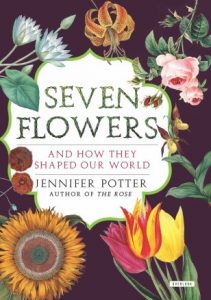Flower Intrigue
By George Graine, Fairfax Master Gardener
“Flowers changed the face of the planet. Without them, the world we know — even man himself — would never have existed.” — Loren Eiseley
Jennifer Potter (author of “The Rose”) has written a unique book called “Seven Flowers: And How They Shaped Our World” (The Overlook Press, 2013). Intrigued by seven flowers, the author writes how they influenced civilizations for hundreds and in some cases thousands of years. The seven flowers are lotus, lily, sunflower, opium poppy, rose, orchid and tulip. What is it about these flowers that they are singled out? Perhaps others could have made the list and no doubt many gardeners have a family story to tell about a specific flower that determined a significant event. Will your own flower choice be as “esoteric” as noted in the Potter book? Your favorite flower may not be among the seven selected; however, this book will surely enlighten you and give you pause to think about your own flower garden.
 Whether one takes flowers for granted or they provide a wonderful memory, there are so many flower types that volumes could be written about them. Of the flowers noted above, the author tells us that “I want to know where my flower originated, when and how they gained their power, what use men made of them in the gardens, and how — or more truly why — their powers transmitted into art.” Potter’s approach to her flower choices follow along the lines of “exerted power or influence of one kind or another, whether religious, spiritual, political, social, economic, aesthetic or pharmacological.” Furthermore, her flower choices indicate “…healing, delirium and death; of purity and passion; of greed, envy and virtue; of hope and consolation; of the beauty that drives men wild. All seven flowers demonstrate the power of flowers to speak metaphorically, if we could only care to listen. It isn’t enough to let flowers bloom; we must also decode what they have to say.”
Whether one takes flowers for granted or they provide a wonderful memory, there are so many flower types that volumes could be written about them. Of the flowers noted above, the author tells us that “I want to know where my flower originated, when and how they gained their power, what use men made of them in the gardens, and how — or more truly why — their powers transmitted into art.” Potter’s approach to her flower choices follow along the lines of “exerted power or influence of one kind or another, whether religious, spiritual, political, social, economic, aesthetic or pharmacological.” Furthermore, her flower choices indicate “…healing, delirium and death; of purity and passion; of greed, envy and virtue; of hope and consolation; of the beauty that drives men wild. All seven flowers demonstrate the power of flowers to speak metaphorically, if we could only care to listen. It isn’t enough to let flowers bloom; we must also decode what they have to say.”
Each flower discussed, from its origin to modern times, is reflected in literature and the arts, and each flower tells a story that is not only informative but also full of surprising facts. There are mythological power and religious episodes (e.g., lotus and lily); banquet ritual (sunflower); and flowers grown for oil (opium poppy) before it became a drug of choice. The rose is like a chameleon because of the variable roles it plays such as love, perfume making and medicine. Orchids have been viewed in opposite ways such as fragrance in the East while in the West it had the name “orchis,” the Greek word for testicles. (You can’t make this stuff up.) Of course, I suspect many of you are familiar with the rise and fall of the tulip. Fortunes were made and lost in Holland and Turkey all because of a virus spread by aphids.
If you are interested in a combination of history and plants, this well-researched book is thoroughly entertaining. In fact, the incredible facts are bound to make your mind wonder and wander about long ago times. As a horticultural historian, the author includes 34 pages of her main sources and a select bibliography of all seven flowers at the conclusion of the book.
By the way, 16 color reproductions could be carefully removed from the book and made suitable for note cards. Also, almost two dozen interesting old black and white illustrations accompany each flower type.
Two other books along historical lines are also worthwhile reads. These are “Legends in the Garden: Who in the World is Nellie Stevens” and “Of Naked Ladies and Forget-Me-Nots: The Stories Behind the Common Names of Some of Our Favorite Plants.”